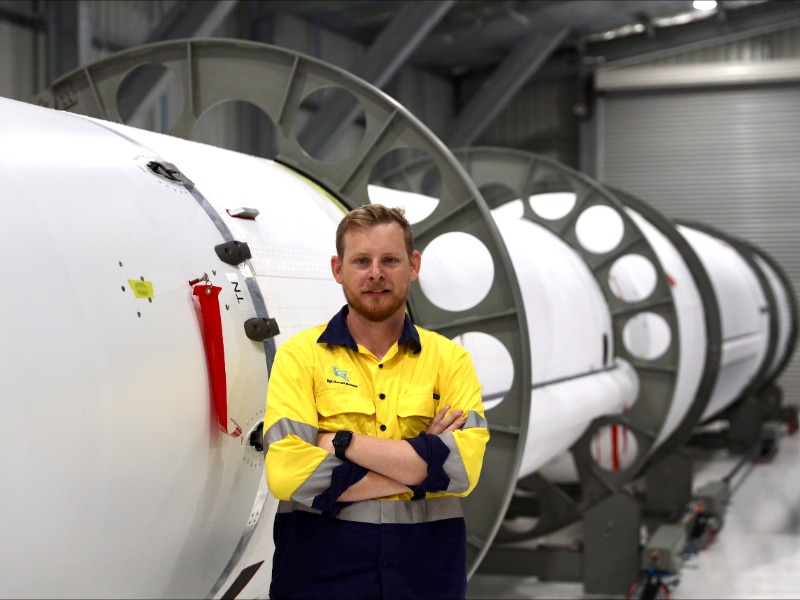Gilmour Space Technologies has completed a full, two-week launch dress rehearsal involving more than 30 operations and ground staff ahead of the maiden launch of its three-stage Eris orbital vehicle.
The best-case scenario for a launch date is early to mid-September as the company is still in dialogue with the Australian Space Agency over the all-important launch permit.
Gilmour director of launch vehicles and satellites Dave Doyle remains optimistic that the process with the Space Agency will deliver a successful result in two to three weeks. But it is not a certainty.
The simple calculus for Gilmour is that without a launch permit, there will be no launch. Mr Doyle says the ongoing information exchange with the space agency has been productive, and while sometimes slow, it continued to move forward.
“We’ve been bouncing back and forwards with responses to requests for information [from the Space Agency] and a refinement on some of the analysis that they have asked us to undertake,” Mr Doyle told InnovationAus.com.

“I would say we are looking at two to three weeks before we would see something from the agency. And then after that we have the 30-day waiting period. So that puts us around early or mid-September and no earlier for launch day.”
Speaking on the sidelines of Cooperative Research Australia’s Collaborate Innovate conference in Brisbane on Wednesday, Mr Doyle said the company had spent the extra time focused on improving launch reliability.
“Just as we have been doing all along, whilst we’ve been processing the information requests and working [on the permit] with the Space Agency, we have continued to do testing, with our focus really on improving the reliability of the launch,” he said.
The company just completed a successful dry dress rehearsal for a full launch, a mission-oriented exercise run on a 24-hour clock.
“We had the vehicle out on the pad, with our entire launch team and support crew up in Bowen – more than 30 people deployed up there for two weeks,” Mr Doyle said. The exercise ran through the entire launch process, just without loading the propellant and gases.
“That moves us forward to the next major milestone, which is the wet dress rehearsal, which is the loading of all of the propellants and [conducting] almost a complete simulation of what we’ll see on launch day. That’s coming up in three weeks.”
Once Gilmour Space Technologies had transported the three-stage Eris vehicle to its Bowen Orbital Spaceport late last year, the company then completed its vehicle integration in late February and hoped to launch in the second quarter.
As ground infrastructure was completed, the rocket was moved to vertical, sitting on its hold-down table next to launch tower in April. But as the information exchange with the Australian Space Agency has dragged, the rocket has been sitting idle for months longer than expected.
Asked whether there were concerns about the conditions of the rocket motors sitting unused over time in the heat and salt air of the Bowen central Queensland coastline, Mr Doyle said of course it is possible that any machinery will degrade over time, but that the company had factored in these issues ahead of time, as part of the production process.
The motors on each of the Eris’ three stages are connected 24×7 to air conditioning units, even as the vehicle has been moved from the vehicle integration building to the launchpad and back again, moving from horizontal to vertical to horizontal.
“The way that we make sure that the engines are in the best possible shape, including if they’ve been sitting in the vehicle for months and months, is by continuous inspection and the quality and process of production,” Mr Doyle said.
“We make sure that we do things like this [and] scan the engines for any kind of imperfections. We protect the engines and other components for the environment that we see in Bowen and for being close to the coast over long periods of time.
“That’s all factored in as part of the manufacturing and production and testing of the components, including the engine. So the designs are tested and the outputs of production are tested to make sure that it’s able to withstand the time periods and the environments that we’re talking about.
“All that built boils down to a simple answer, which is: Yes, we do expect to see potential degradation. But we have designed for that, we have catered for it, and we test for it and we inspect for it on an ongoing basis.”
In the meantime, the company is well advanced in production of the second and third Eris vehicles on the Gold Coast, which has been going on in the background even as the first rocket is sitting in Bowen waiting for blast off.
Gilmour is targeting six months after the first launch before sending up its second Eris vehicle.
Do you know more? Contact James Riley via Email.

